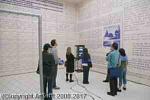Rirkrit Tiravanija
Rirkrit Tiravanija
Born: 1961
Biography:
Rirkrit Tiravanija is a contemporary artist residing in New York City, Berlin, Chiang Mai, and Lamma Island, Hong Kong. He was born in Buenos Aires, Argentina in 1961. His installations often take the form of stages or rooms for sharing meals, cooking, reading or playing music; architecture or structures for living and socializing are a core element in his work.
The son of a Thai diplomat and an oral surgeon, Tiravanija was born in Buenos Aires in 1961 and was raised in Thailand, Ethiopia, and Canada. After initially studying history at Carleton University, he later enrolled in the Ontario College of Art in Toronto (1980–84), the Banff Center School of Fine Arts (1984), the School of the Art Institute of Chicago (1984–86), and the Whitney Independent Studies Program in New York (1985–86). He moved to Manhattan in 1982.
According to art historian Rochelle Steiner, Tiravanija's work “is fundamentally about bringing people together.” The artist's installations of the early-1990s involved cooking meals for gallery-goers. In one of his best-known series, begun with pad thai (1990) at the Paula Allen Gallery in New York, he rejected traditional art objects altogether and instead cooked and served food for exhibition visitors. He recreated the installation in 2007 at the David Zwirner gallery in Chelsea using the original elements and renaming the work untitled (Free/Still). In 1995 he presented a similar untitled work at the Carnegie International exhibition at the Carnegie Museum of Art, where he included wall text that presented written instructions for cooking South-east Asian green curry, which was then prepared for visitors. As a prelude to the opening of La Triennale 2012, Tiravanija was invited to transform the main nave of the Grand Palais into a festive, large-scale, twelve-hour banquet composed of a single meal of Tom Kha soup (Soup/No Soup, 2012).
His exhibitions are often based on interaction and exchange among participants. Some viewers, like the students who lived in Untitled 1999, a recreation of Tiravanija's East Village apartment, actually moved in for the duration of an exhibition. A 2005 solo show at Serpentine Gallery, London, featured two new, full-scale replicas of this apartment, complete with kitchen, bath, and bedroom. In other projects, he has bricked up the entrance to gallery spaces, rendering them impenetrable for the duration of the respective exhibition, and has painted the words " Ne Travaillez Jamais" on the wall, a phrase lifted from the May, 1968, protest riots in Paris.
When Tiravanija does make objects, they are most often multiples and ephemera connected with exhibitions. Since the early 1990s, Tiravanija has published multiples in the form of backpacks, cooking utensils, and maps as part of his practice. These commonplace objects used for cooking or camping serve today as memories of the artist’s earlier projects and also stimulate new interactions, whether physical or purely in the imagination. In Untitled 2008–2011 (the map of the land of feeling), Tiravanija presents a visual chronology of his life and work between 1988 and 2008, as told through the pages of his expansive passport.
In 1997 Tiravanija began an engagement with modernist architecture when he installed in the Museum of Modern Art's sculpture garden Untitled: 1997 (Glass House), a child-size version of Philip Johnson's Glass House (1949). Similarly, untitled 2002 (he promised) is an arena of activities ranging from DJ sessions to film screenings within a chrome and steel structure inspired by Rudolf M. Schindler's Kings Road House (1922) in West Hollywood. In Tiravanija’s untitled 2006 (pavilion, table and puzzle) installation, visitors are welcome to gather at a picnic table to assemble an expansive puzzle depicting Eugène Delacroix’s 1830 masterpiece, Liberty Leading the People; a pavilion-like structure, a replica of one designed by Jean Prouvé for use in French colonial Africa, completes the tableau. For Asile Flottant (2010), he constructed a sketch of Le Corbusier’s boat of the same name and inserted a section of it into a gallery. Le Corbusier’s barge was designed for the Salvation Army literally as a floating asylum meant to provide temporary overnight shelter for vagrants wandering the streets of Paris; Tiravanija’s barge, constructed in Chiang Mai, was to serve as a pavilion that houses both political T-shirts designed by the artist, and others that have been collected from all over the world.
In 2004 the Solomon R. Guggenheim Museum in New York honoured Tiravanija with the Hugo Boss Prize and presented an exhibition of his work, which had more overtly political tones. Featured in this exhibition, Untitled 2005 (The Air Between the Chain-Link Fence and the Broken Bicycle Wheel) was an installation in which the artist addressed governmental control of popular media by installing a low-tech pirate television station within the museum, using a simple metal antenna and cables as broadcasting equipment, accompanied by a small wooden structure housing a television set and chairs. On the gallery walls Tiravanija featured the text of the US Constitution’s First Amendment (advocating freedom of speech), a history of radio and television communication in America, and simple directions for constructing low-tech broadcasting equipment. Tiravanija’s support of free speech is conveyed by his choice to broadcast the low-budget film Punishment Park (1971), a documentary on the suppression of Vietnam War protests.
More...














